1917: The Runanga Payroll Robbery
November 9, 2022
By AHNZ
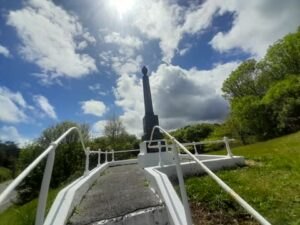 Whenever an historical narrative is cemented into the earth with a monument it makes a statement that brands as an instant deviant anyone who challenges it. After a dozen or so consultations of what really happened on 9 November, 1917, to the Rununga miners’ payroll all I can find are agreement with the mainstream handed-down story given to us by government. A masked man intercepted the 3 men driving the cash payroll from Greymouth to Rununga, shot 2 men dead, and made off with £3659+ in cash. This man was Will McMahon, an Australian, whose birth name was Frederick William Eggers.
Whenever an historical narrative is cemented into the earth with a monument it makes a statement that brands as an instant deviant anyone who challenges it. After a dozen or so consultations of what really happened on 9 November, 1917, to the Rununga miners’ payroll all I can find are agreement with the mainstream handed-down story given to us by government. A masked man intercepted the 3 men driving the cash payroll from Greymouth to Rununga, shot 2 men dead, and made off with £3659+ in cash. This man was Will McMahon, an Australian, whose birth name was Frederick William Eggers.
According to mainstream history, Eggers was a fraudster turned to murder who was funded by a divorcee mother of three. He was captured by the clever policemen and upstanding New Zealand legal system before being hanged at Lyttleton Gaol just 5 months later. This was the South Island’s last capital punishment, carried out on 5 March, 1918, by a local farmer as executioner after a couple of false starts trying to activate the noose mechanism. Most of this information is succinctly emblazoned on a big roadside monument along State Highway 6 just north of Greymouth so there will be no doubt and not questions asked.
The Mayor of Greymouth earlier in this, our local elections year, told the community she had asked for the memorial to be tidied up. Trite little ‘knowing’ remarks came back re-enforcing the narrative but I wonder suspiciously if any of these people really know, by study or by received oral history, what they’re even talking about?
“…September 1917, the driver of a brewer’s cart a few minutes ahead of the [payroll] mine car fond a tree across the road, about a kilometer before Rununga. He stopped and pulled the branch off the road. Two weeks later, the same thing happened – a tree was found lying across the road and removed minutes before the car arrived- this time by a young local boy called Alex Brown, who was riding home on his bike. Again the mine car proceeded unimpeded.” – p30, Trevor Conn, Gittens (2001)
“It was then a masked man stepped out from behind a nearby bush. With a gun in both hands, he yelled, “HANDS UP!!!” and started shooting. He fired off 7 bullets, instantly killing John Coulthard where he stood. William Hall took a bullet to the spine and somehow, his clothes caught fire as he sat there helpless. Isaac James was shot in his thigh, calf and hand as he fled for his life, disappearing from the killer’s view.” – CANTERBURY’S AND THE SOUTH ISLAND’S LAST HANGING – 5TH MARCH 1918, DISCO
“History. It’s the little things that count too. Well done.” and “The great pay hoist. Tragic story but a very important part of our history” and “Wow. I love it when History is brought back to the surface after being lost. Well done Tanya – its important these stories stay alive.” – Ref. Tania Gibson Grey District Mayor, Facebook (2022)
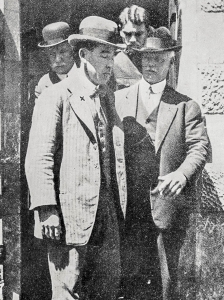 Will McMahon was up against The State and never really stood a chance at a fair trial. A series of procedural and unprofessional mistakes would never have seen him to the gallows or even New Zealand’s highest punishment in the modern day. This, remember, was the time of the Great War. In terms of time period NZ was in a Fourth Turning Crisis characterised by aggressive institutions and new uses of public authority. Antisocial behavior was clamped down on, public order tightened, crime met with harsh reception. The State had been embarrassed and authority questioned by having its mine attacked, paymasters shot dead, and its police eluded.
Will McMahon was up against The State and never really stood a chance at a fair trial. A series of procedural and unprofessional mistakes would never have seen him to the gallows or even New Zealand’s highest punishment in the modern day. This, remember, was the time of the Great War. In terms of time period NZ was in a Fourth Turning Crisis characterised by aggressive institutions and new uses of public authority. Antisocial behavior was clamped down on, public order tightened, crime met with harsh reception. The State had been embarrassed and authority questioned by having its mine attacked, paymasters shot dead, and its police eluded.
Their method of transporting a huge amount of money was highly suspect. Despite 2 prior incidents where the road was blocked at the perfect ambush point they had kept on using it, only upgrading to a strong room in a guarded train after they had learned this hard lesson. Somebody had to be found to hang this crime upon quickly and introduced, quickly, to a short drop with a sudden stop. Look it up, if you have a moment, the word ‘telishment’.
Nobody had a positive identification of the masked robber at all so who could say it was McMahon? Hall and Coulthard were dead. Two locals on cycles, the Mandersons, were unable to make an identification but only help the dying after the robber had fled. The star witness was a 9yo boy, Alex Brown, and the best he could do was to claim McMahon was the same disheveled man he had seen skulking about a hut near to the crime scene. McMahon’s manner, build, and dress contrasted with this description. He dressed very well, was strongly built, and had plenty of money which he used to stay at hotels. Prior to this identification the photograph of McMahon had been circulated in public in the local newspapers which contaminated the child’s knowledge claims. Supreme Court Justice Chapman had no problem hanging the case on the boy.
“The person’s witnessing the shooting were my grandfather Peter Manderson Jnr & his eldest son Leonard. They were probably cycling to visit Peters father Peter snr who farmed some land at “the Camp” about 2 miles away towards Greymouth.Peter snr was also a miner.” – Jack N Pat Manderson, West Coast Recollect (2019)
“Following the hold up mine pays were taken from Greymouth by train. A heavy timbered room was built into a guard’s van. The pays were kept inside that room with an armed bank employee. Mr Grandfather James Laing as a new and young employee was sent out with his first pay run. He was expected to ride in the guard’s van. He was very concerned as to his own well being, should there a holdup, that he made so much noise shouting out that the person inside the Strongroom let James inside and that was where he went with subsequent pays.” – Bob Laing, ibid
“At the Supreme Court trial Eggers put on a brave face- standing in the dock dressed with his usual meticulous car…His lawyer…argued that the jury could not rely on someone so young…The judge disagreed, directing the jury that the boy was old enough to give reliable evidence.” – Gittens (2001)
“From the outset, it was palpable that the jury would be asked to infer that the identification of Eggers by the witnesses who saw him in the empty house and at the other places in the vicinity of the scene of the crime was influenced by the publication of accused’s photograph in the Greymouth newspapers prior to the identification.” – quoted in The Golden Grey, Tony Kokshoorn (2011)
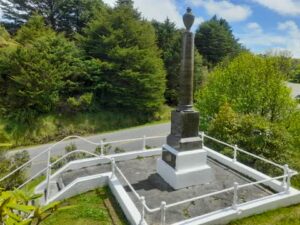 According to the Grey River Argus a few weeks before his execution it was supposed that he came to New Zealand four or five years before and little was known of his movements since! How could New Zealanders be so un-informed about the man they were to kill? A man, by the way, who always maintained his innocence right up to the moment his life was taken. His own claim is that he was a land speculator, a legitimate businessman visiting the West Coast. It is claimed that he was charged with but not exactly convicted for fraud in Australia which, if true, may speak to his character. On the other hand it might be Australian police telling helpful stories to help out their New Zealand cousins as they tried to prosecute a difficult trial. If so, it reminds us of Changeling (2008) where the LAPD in the 1920s claims to have solved a missing persons case by re-uniting Angelina Jolie’s character with her son. Based on a true story, the mother’s insistence that the boy was not her son at all was a problem for the ‘victorious’ police and press so she was pressured to suppress this ‘little’ matter for the sake of the public good.
According to the Grey River Argus a few weeks before his execution it was supposed that he came to New Zealand four or five years before and little was known of his movements since! How could New Zealanders be so un-informed about the man they were to kill? A man, by the way, who always maintained his innocence right up to the moment his life was taken. His own claim is that he was a land speculator, a legitimate businessman visiting the West Coast. It is claimed that he was charged with but not exactly convicted for fraud in Australia which, if true, may speak to his character. On the other hand it might be Australian police telling helpful stories to help out their New Zealand cousins as they tried to prosecute a difficult trial. If so, it reminds us of Changeling (2008) where the LAPD in the 1920s claims to have solved a missing persons case by re-uniting Angelina Jolie’s character with her son. Based on a true story, the mother’s insistence that the boy was not her son at all was a problem for the ‘victorious’ police and press so she was pressured to suppress this ‘little’ matter for the sake of the public good.
During the robbery McMahon actually was visiting a famous New Zealand family, or trying to, with the stated intention of buying land at Kokatahi. John and Mary Graham were among the first settlers at Kokatahi where they farmed, owned-managed the Longford Hotel, and formed the heart of that local and isolated community. It was here that the famous West Coast Kokatahi Band formed in 1912. McMahon was calling on the Grahams based on a conversation he had with them earlier in Greymouth but as they were not home he was unable to. Instead, he had his driver show him around the district near Lake Kanieri. The elderly Graham couple was the alibi and lifeline McMahon’s defense needed but the couple claimed amnesia. If McMahon was indeed man-hunted, framed by the law, killed by The State, and ‘history’ set into a stone monument then this would be supreme karmic irony for the Grahams. Their own son, Stanley Graham, would be man-hunted, framed by the law, killed by The State, and ‘history’ set into a huge stone road-side monument. Ref. 1941: The Graham Manhunt, AHNZ
“There is a farm of one hundred acres in connection with the establishment, and another of thirty-seven acres is held in the district by Mr. Graham. In the Koiterangi district he also holds 200 acres, and Mrs Graham, 101 acres.” – The Cyclopedia of New Zealand (1905,) NZ Electronic Texts
“J Mary Graham wife of John Graham, farmer, Kokatahi, deposed that early in October last year she and her husband left Hokitika for Nelson. Neither witness nor her husband had any business dealings with the accused; she had only seen him once in the Royal Hotel at Greymouth. To Mr Hunter: Her husband was in the room at the time. There might have been some talk about land in the vicinity of their farm at Kokatahi. She could not remember accused saying that he might call on them to look at the land. John Graham, husband of the witness, at a later stage, gave similar evidence.” – Press (1918,) Papers Past
“As the butt of the weapon appeared above the top of the case, the alert Detective Norman Abbott glimpsed it and dived at his man to grasp both hands. “You murderer! You have got a revolver. You were going to shoot us,” he said, according to his evidence given at the trial. His companion, Detective Daniel Connolly, was no less quick and clamped handcuffs on the struggling Eggers.” – NZ Truth (1918,) Kokshoorn (2011)
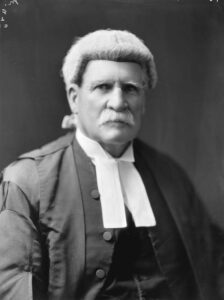 McMahon left Hokitika, proceeded to Christchurch via Otira without returning to Greymouth. This is alleged suspicious behavior by some media outlets but why should it be? There was no Otira Tunnel yet. Soon after arriving in Christchurch McMahon was set upon by detectives who detained and searched him on the grounds that all new arrivals from the West Coast were subject to this treatment. Civil rights and police procedures in 1917 didn’t count for much. Upon discovering McMahon’s girlfriend’s revolver in a bag the detectives summarily declared “You murderer,” “you were going to shoot us!” and set upon McMahon, roughing him up no doubt, and then making the arrest. Next, McMahon was hauled off back to Greymouth through a near-riot of agitated locals to a Magistrate’s Court. McMahon was denied a legal defense at this crucial juncture and the case referred up to the Supreme Court back in Christchurch. The agitated public would not have been happy with their lawmen had they done anything less. McMahon’s photo, remember, had been all over the newspapers already as ‘the’ murderer. The Justice system didn’t trouble itself with having a fair or clean trial of the facts. Police didn’t even hide their pre-judgements before the arrest but admitted them freely at court.
McMahon left Hokitika, proceeded to Christchurch via Otira without returning to Greymouth. This is alleged suspicious behavior by some media outlets but why should it be? There was no Otira Tunnel yet. Soon after arriving in Christchurch McMahon was set upon by detectives who detained and searched him on the grounds that all new arrivals from the West Coast were subject to this treatment. Civil rights and police procedures in 1917 didn’t count for much. Upon discovering McMahon’s girlfriend’s revolver in a bag the detectives summarily declared “You murderer,” “you were going to shoot us!” and set upon McMahon, roughing him up no doubt, and then making the arrest. Next, McMahon was hauled off back to Greymouth through a near-riot of agitated locals to a Magistrate’s Court. McMahon was denied a legal defense at this crucial juncture and the case referred up to the Supreme Court back in Christchurch. The agitated public would not have been happy with their lawmen had they done anything less. McMahon’s photo, remember, had been all over the newspapers already as ‘the’ murderer. The Justice system didn’t trouble itself with having a fair or clean trial of the facts. Police didn’t even hide their pre-judgements before the arrest but admitted them freely at court.
The prosecution didn’t have much evidence to kill McMahon with and apparently knew this. They set up a trick visitor’s room with McMahon’s girlfriend whose name he had taken for his own, probably thinking it was an endearment and a better monika for business than ‘Eggers’. What McMahon said to McMahon was taken down by a police spy and used against the defendant in the trial as a surprise attack. They had said little to incriminate but apart from the 9yo boy and dirt from Australian police there wasn’t much else to throw at the accused.
By this time McMahon had a lawyer to defend him which should have been fairly easy. It was true that McMahon was in possession of the stolen money. It was also true he had knowledge of the crime because he supplied detailed information leading police to a camouflaged dug-out and the discovery of the robber’s mask and clothing. The job of the prosecution was to show, beyond reasonable doubt, that McMahon was guilty of murder but they couldn’t do it. Fortunately they had Justice Frederick Revans Chapman to duct-tape up the holes in the prosecution. A contaminated 9yo boy excited by fame says McMahon was there? Good enough. McMahon having the money now isn’t the same as killing men and stealing it? Close enough. The masked robber was shot in the chest by Hall yet McMahon’s body had no evidence of injury? Let that go. Chapman instructed the jury they “had the right to assume that the man in whose possession the money was found was the man who had committed the crime.”¹ Chapman really helped the Government out on this one as perhaps his famous judge father, Henry Samuel Chapman, had done for the early New Zealand State and his famous brother Martin Chapman and his firm (Chapman Tripp) has done ever since?
“Hall, who’d been shot in the arm, had managed to draw his revolver and sqeeze off a couple of shots. One of them hit the highwayman but had no effect, as if he was wearing armor.” – Gittens (2001)
“Chapman took a firm line with offenders he thought required deterrent sentences. His sentencing of the Māori leader Rua Kēnana was criticised as being unnecessarily punitive; eight of the jurors protested in a petition to Parliament…During his judicial career Chapman was active behind the scenes in giving advice to the government on law reform, particularly in criminal law and procedure…He was profoundly affected by the loss of his two sons, the younger in 1915 in the war in Europe, and the elder by suicide the following year.” – Encyclopedia of New Zealand (1996)
“I think that when statesmen forsake their own private conscience for the sake of their public duties, they lead their country by a short route to chaos.” – Thomas Moore in A Man for All Seasons (1966)
“The world must construe according to its wits; this court must construe according to the law.” – ibid
Police had edited correspondence between McMahon and McMahon, along with spying on them, in a breach of police procedure that would never stand today. They received a letter claiming to be from the “real killer” and dismissed it. Even up to the final moments, McMahon said he was not the murderer: “I stand here as a condemned man with two moments to live and I say that I am not the man that did the shooting…I never shot John Coulthard.” Even this was taken from McMahon as the prison governor retroactively told the press the true last words were “I should have shot the kid on the bike.”² The System really did a complete job on circling the wagons on this one.
In Chapman’s court McMahon was guilty until proven innocent but the defense relied upon another rule: Innocent until proven guilty. Chapman was a man of his time (the New Zealand Fourth Turning) and so didn’t see his role as giving justice and rights to individuals so much as to collective society. He had treated Rua Kenana the same way in 1916 in considering his punishment as an object lesson to the Maori race in obedience above, or along with, considerations of the man and his legal rights. According to his entry in the Encyclopedia of New Zealand Mr Justice Chapman had also been hard hit by the very recent deaths of his sons which may explain being compromised in his judicial soul.
This telling of the past, as usual, differs greatly to the mainstream narrative. Anarchist History seeks to start from first facts then work to conclusions rather than be self-expressed subject to the pre-approved consensus. We want to know what really happened rather than prop up or be rewarded by an existing paradigm; Innovative rather than submissive. McMahon might be the Eggers, the murderer, the monument and the consensus says he is but then why can’t this problems with the case be written about and why don’t we discuss them? New Zealand’s origin story should be founded on the truth rather than fiction if only because it’s unlikely we can invent enough creative fiction to out-reality reality. Certainly we can’t invent a new back-story for New Zealand based on lies unless we are prepared to do injustice to each other which includes killing people from time to time for crimes they did not commit.
—
1 p37, Gittens (2001)
2. ibid
Image ref. Justice Chapman, Encyclopedia of New Zealand (1996)
Image ref. Hall-Coulthard monument, AHNZ Archives (7 October, 2022)
Image ref. McMahon escorted out of Greymouth magistrate’s court still having had no lawyer, Auckland Libraries Heritage Collections; Dispatches
Ref. I Should Have Shot the Kid, Trevor Conn; Epitaph II, Paul Gittens (2001)
Note: “One intriguing fact is Eggers’s use of Colt 32 calibre automatic pistols capable of rapid fire while Coultard used an old fashioned single action revolver. Something I have wanted to find out is how Eggers got hold of these pistols as at this time they were supposedly available to only the military.”- Les Holmes Germanicus, Comment to AHNZ (2022)
4 thoughts on "1917: The Runanga Payroll Robbery"
Leave a Reply
 Like Comment Share
Like Comment Share

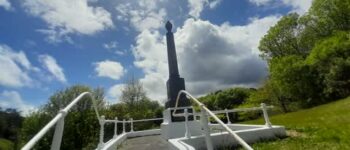




Very well written article.. interesting.
Thank you. I don’t set out to disagree with mainstream history but I don’t resist when it calls!
Stan Graham was not framed as said in an above statement.There may be problems with the number of people he shot (the last two) but he was definitely not framed.
I’m not convinced but would love to hear what you think about the AHNZ post on that incident.
Ref. http://ahnz.anarkiwi.co.nz/1941-the-graham-manhunt/